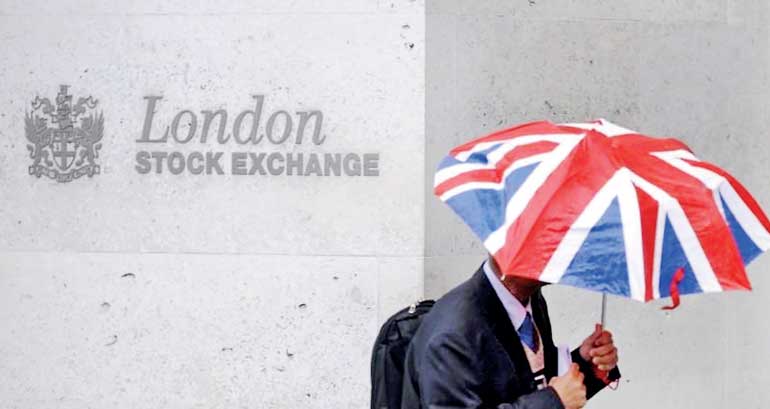Monday Dec 29, 2025
Monday Dec 29, 2025
Tuesday, 15 August 2017 00:01 - - {{hitsCtrl.values.hits}}
 London (Reuters): World stocks rose on Monday, recovering some of their poise after fears of a US-North Korea nuclear standoff drove them to the biggest weekly losses of 2017, while the dollar too rose off four-month lows it had hit against the yen.
London (Reuters): World stocks rose on Monday, recovering some of their poise after fears of a US-North Korea nuclear standoff drove them to the biggest weekly losses of 2017, while the dollar too rose off four-month lows it had hit against the yen.
US shares were expected to open higher, index futures showed ESc1 1YMc1.
European shares bounced after falling nearly 3% last week, with the pan-European STOXX 600 up 0.9% following a similar jump in MSCI’s index of Asia-Pacific shares outside Japan.
Those gains were led by bounces in Australia, Hong Kong and South Korea .HSI .KS11 while MSCI’s world index rose 0.2% .
US S&P e-mini futures ESc1 rose 0.6%, suggesting a higher open later in the day while the CBOE volatility gauge, better known as the VIX, slipped off nine-month highs hit on Friday .VIX
“The sell-off was around the North Korea risk and escalating rhetoric. It seems to have died down a bit now,” said Caroline Simmons, deputy head of the UK investment office at UBS Wealth Management.
“This week we’re seeing a return to fundamentals which are quite good,” Simmons said. “(Company) earnings have been in line or slightly above expectations, global growth seems OK.”
Last week’s equity losses - and yen gains - were sparked by a war of words between Pyongyang and Washington after US President Donald Trump warned North Korea it would face “fire and fury” if it threatened the United States. That prompted North Korea to say it was considering plans to fire missiles at the US-held Pacific island of Guam.
While North Korea’s Liberation Day celebration on Tuesday to mark the end of Japanese rule could see tensions rise again, markets are relieved that the weekend passed without more rhetoric. US officials also played down the likelihood of a nuclear conflict with North Korea.
Tokyo shares failed to partake in the region’s gains however, slipping 1% to three-month lows .N225 even after data showing robust 1.0% second quarter growth in Japan, the sixth straight quarter of expansion.
That was due to worries over the potential impact of the yen’s recent surge against the dollar. N225. The Japanese currency, which firmed around 1.4% last week, tends to benefit during times of geopolitical or financial stress as Japan is the world’s biggest creditor nation.
Japanese investors also repatriated cash held overseas.
The greenback rose 0.5% to 109.70 yen JPY= after slipping to 108.720 on Friday, its weakest since April 20. Against a basket of currencies it firmed 0.2%, rising off last week’s 10-day lows .DXY.
It also firmed 0.6% against the Swiss franc, another currency which is favored during times of stress and touched two-week highs last week CHF=.
“Easing regional geopolitical tensions are taking a toll on the yen, with the currency being the key underperformer (along with safe haven peer Swiss franc) globally,” ING Bank analysts told clients.
“As long as the geopolitics ease, we look for dollar/yen to gradually grind higher along with gently higher US yields.”
Recovering economy
The Japanese data was interpreted by some as another sign that the global economy is indeed on the mend, with possible consequences for central banks’ easy-credit policies.
While Japan is not expected to dismantle its stimulus program any time soon, analysts reckon that signs of global recovery gives euro zone and U.S. central banks a reason to start rolling back some of their asset purchases.
The data helped push US 10-year yields US10YT=RR higher from Friday’s six-week lows, touched after showing that US consumer prices rose just 0.1% last month, below economists’ forecast of a 0.2% gain.
The yield on Germany’s 10-year government bond DE10YT=TWEB, the benchmark for the euro zone, was up 3.8 bps to 0.42%, a move mirrored by most other euro zone debt. The yield had hit the lowest since end-June on Friday.
“The question becomes how Japanese growth could impact the very expansionary stance of central banks,” said Daniel Lenz, a strategist at DZ Bank.
Markets could glean some clues on that from minutes of the latest US Federal Reserve and the European Central Bank meetings, due on Wednesday and Thursday respectively.
Earlier in the day, Chinese markets were largely unfazed by a slew of activity data which was softer than forecast, though still largely solid.
The world’s second-largest economy had been widely expected to lose some steam after a surprisingly strong first half of 2017. But economists do not expect a hard landing, with the government keen to ensure stability ahead of a Communist Party leadership reshuffle in the autumn.
However, the weak Chinese data hit oil prices, with Brent crude futures LCOc1 down 42 cents at $ 51.68 a barrel.